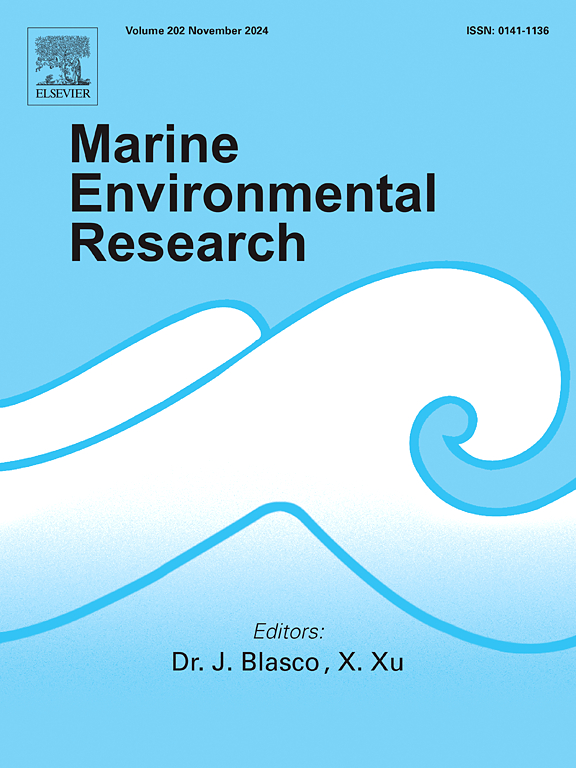From subsea power cable to small-spotted catshark Scyliorhinus canicula: Behavioural effects of electromagnetic fields in tank experiments
IF 3
3区 环境科学与生态学
Q2 ENVIRONMENTAL SCIENCES
引用次数: 0
Abstract
Subsea power cables are expanding in number and capacity due to increasing demand to transport offshore generated energy. Energy transported through a cable creates an electromagnetic field (EMF). Elasmobranchs are dependent on their perception of the earth's magnetic field and biologically induced electric fields, for orientation, navigation, locating conspecifics and detecting prey. EMF levels from subsea power cables will add to natural signals potentially disrupting elasmobranch perception, but the effects are not fully understood. Reported behavioural responses include attraction, disturbance, and indifference, varying with exposure type, level and experimental set-up. In this study, the effects of EMF on swimming behaviour of 14 individual small-spotted catshark Scyliorhinus canicula were studied. All sharks were exposed to field-relevant EMF gradients cables in three trials: 15.0 μT AC, 19.6 μT DC, and a control treatment. Sharks showed no startle response to EMF onset, did not alter movement towards or away from the cable, and crossed it as frequently as in control trials. Hidden Markov Models showed that behavioural states were best explained by EMF treatment, trial order and sex. Sharks showed 25 % less time transiting during DC trials when compared to AC and control trials. These findings indicate reason for further refined studies to better determine behavioural effects from direct current subsea power cables with S. canicula, for example using tagging studies. In addition, exploring effects on other species will help obtain a broader understanding of the potential impacts of EMF on benthic elasmobranchs.

从海底电力电缆到小斑点猫鲨:水箱实验中电磁场的行为影响
由于海上发电需求的增加,海底电力电缆的数量和容量正在不断扩大。能量通过电缆传输产生电磁场(EMF)。弹力枝依靠它们对地球磁场和生物感应电场的感知来定位、导航、定位同种生物和探测猎物。海底电力电缆产生的EMF水平会增加自然信号,可能会破坏elasmobranch的感知,但其影响尚不完全清楚。报告的行为反应包括吸引、干扰和冷漠,随暴露类型、水平和实验设置而变化。本研究研究了电磁场对14条小斑点猫鲨个体游泳行为的影响。在三个试验中,所有鲨鱼都暴露于与场相关的EMF梯度电缆中:交流15.0 μT,直流19.6 μT和对照处理。鲨鱼对电磁场没有表现出惊吓反应,没有改变靠近或远离电缆的运动,并且与对照试验一样频繁地穿过电缆。隐马尔可夫模型显示,行为状态最好用电磁场治疗、试验顺序和性别来解释。与交流试验和对照试验相比,鲨鱼在直流试验中传递的时间减少了25%。这些发现表明了进一步完善研究的理由,以更好地确定带有S. canicula的直流海底电力电缆的行为影响,例如使用标记研究。此外,探索对其他物种的影响将有助于更广泛地了解电磁场对底栖板鳃类的潜在影响。
本文章由计算机程序翻译,如有差异,请以英文原文为准。
求助全文
约1分钟内获得全文
求助全文
来源期刊

Marine environmental research
环境科学-毒理学
CiteScore
5.90
自引率
3.00%
发文量
217
审稿时长
46 days
期刊介绍:
Marine Environmental Research publishes original research papers on chemical, physical, and biological interactions in the oceans and coastal waters. The journal serves as a forum for new information on biology, chemistry, and toxicology and syntheses that advance understanding of marine environmental processes.
Submission of multidisciplinary studies is encouraged. Studies that utilize experimental approaches to clarify the roles of anthropogenic and natural causes of changes in marine ecosystems are especially welcome, as are those studies that represent new developments of a theoretical or conceptual aspect of marine science. All papers published in this journal are reviewed by qualified peers prior to acceptance and publication. Examples of topics considered to be appropriate for the journal include, but are not limited to, the following:
– The extent, persistence, and consequences of change and the recovery from such change in natural marine systems
– The biochemical, physiological, and ecological consequences of contaminants to marine organisms and ecosystems
– The biogeochemistry of naturally occurring and anthropogenic substances
– Models that describe and predict the above processes
– Monitoring studies, to the extent that their results provide new information on functional processes
– Methodological papers describing improved quantitative techniques for the marine sciences.
 求助内容:
求助内容: 应助结果提醒方式:
应助结果提醒方式:


